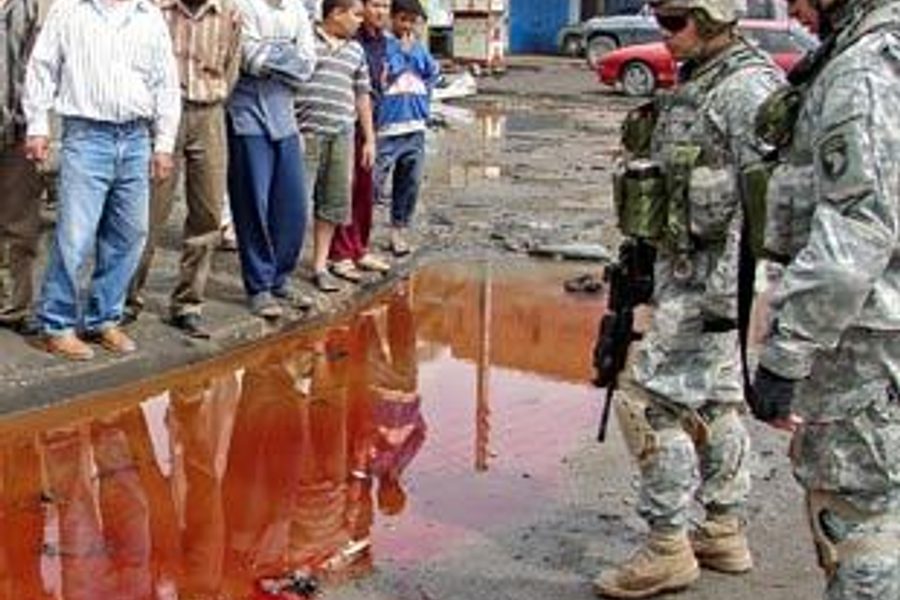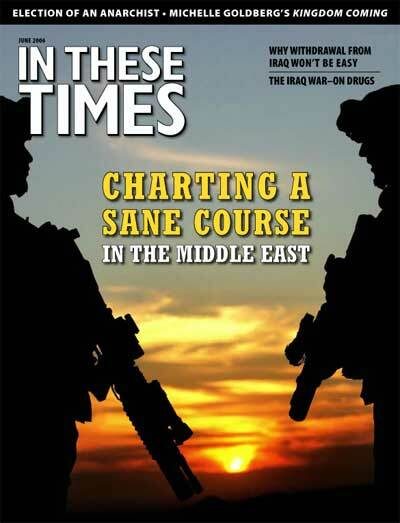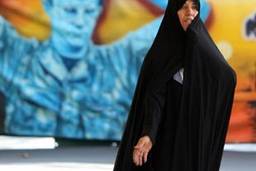Why Exiting Iraq Wont Be Easy
Iraqis may hate the occupation, but they fear U.S. withdrawal
Chris Toensing

When 300,000 protesters assembled in New York City in late April urging President George W. Bush to “bring all the troops home now,” the response from the Bush administration was familiar: silence.
Despite polls showing that majorities of Americans now believe the war was a mistake, Washington has no plans for ending the occupation of Iraq, either now or any time in the near future. Not one of the retired generals who came forth in mid-April to blast Defense Secretary Donald Rumsfeld’s mishandling of the war is calling for a pullout. And top Democrats, such as Senators John Kerry and Ted Kennedy, who are demanding a timetable, are still lonely voices in their own party.
While critics of the occupation focus their ire on Washington, there is similar paralysis at the top in Baghdad, despite widespread popular anger at the U.S. presence. Muwaffaq al-Rubaie, the Iraqi national security adviser tied to the Shiite Dawa Party, is willing to talk about a “condition-based” withdrawal of some U.S. troops, but views a substantial U.S. military presence as the country’s “insurance policy.” His Sunni Arab counterparts in government agree. “Any withdrawal of the American forces now will lead the country into a civil war,” says Tariq al-Hashimi, the leader of the Iraqi Islamist Party tapped to be a vice president in Iraq’s new “national unity” government.
In fact, the country is already in the throes of a civil war. “What we have going on in Iraq is a low-level civil war,” says Patrick Lang, former chief of Middle East intelligence at the Defense Intelligence Agency, “with the Iranians standing in the background, smiling.” Each day in Iraq brings fresh news of sectarian violence. Car bombs target police stations, mosques and markets in heavily Shiite Arab neighborhoods of the capital. In Baghdad and other cities, dozens of men are turning up dead in drainage ditches and garbage dumps, their hands bound, most of them shot execution-style in the back of the head.
This conflict has been underway since at least early 2005, but it ratcheted up after the February 22 bombing of the Askariyya shrine in Samarra. In early May, using morgue records, the Los Angeles Times documented at least 3,800 violent deaths in Baghdad alone during the first three months of 2006, many of them execution-style slayings. That means that civil strife in Iraq is bloodier in absolute terms than that which devastated Lebanon from 1975 to 1990.
In the face of Iraq’s slow-motion implosion, the White House insists on staying the course. The Bush administration is still betting that, in time, the United States can “draw down” thousands of soldiers, though perhaps not from a few permanent bases, in consultation with a stable, U.S.-friendly Iraqi government. But it is increasingly apparent that the accelerating civil war, as well as political and budgetary realities in Washington, will dictate otherwise. The United States, having done so much to break Iraq, has now become powerless to fix it.
— — — — — — — — — — -
The aim of the roughly 20,000 Sunni Arab insurgents has always been to drive out the U.S. military, but now (and even more so) it is to cripple the Shiite-dominated government brought to power by U.S.-sponsored elections. On the other side of the civil war, elements of the security forces loyal to the Shiite parties, as well as militias such as the Badr Corps and the Mahdi Army, exact revenge for both the bombings and the depredations of Saddam Hussein’s regime. Each side has killed civilians simply because of their religious affiliation, leading some Iraqi truckers to carry two driver’s licenses, one with a Sunni-sounding name for the Sunni areas and one with a Shiite-sounding name for the Shiite areas.
To be sure, the current conflict is historically rooted in the deposed regime’s repression. “We unscrewed the lid on the jar,” Lang reckons. But the extent of the mayhem was not inevitable.
“To a large extent the chaos is of U.S. making,” says Iraqi scholar Isam al-Khafaji, who quit in disgust after serving two months in 2003 with the Iraqi Reconstruction and Development Council, a group of returned expatriates who advised the Coalition Provisional Authority (CPA). In the summer of 2003, the CPA dissolved the heavily Sunni Arab officer corps of the Iraqi army, just as the U.S. military was beginning the first of its indiscriminate sweeps in the “Sunni triangle.” Together with the vengeful “debaathification” policies pushed by Ahmad Chalabi and other former exiles, these policies convinced Sunni Arabs that they would be treated as the enemy in post-Saddam Iraq.
The CPA made its most damaging decision in July, when it allocated seats in the Iraqi Governing Council to Shiite Arabs, Kurds, Sunni Arabs, Turkmen and Christians according to estimates of their share of the population. For the first time, sectarian and ethnic affiliation became the formal organizing principle of Iraqi politics, exacerbating the tendency of Iraqi factions to pursue maximum benefits for their own community at the expense of Iraq as a nation. Sectarian and ethnic divisions deepened and widened with each “milestone” in the U.S.-sponsored transition to electoral democracy.
— — — — — — — — — — -
Through ideological rigidity and incompetence, therefore, the United States has midwifed both an anti-occupation guerrilla war and an unconventional civil war over control of the country and its petroleum resources after the United States departs. The two wars are tightly intertwined.
On the one hand, the U.S. occupation remains a key reason behind Sunni Arab anger with the post-Saddam order – and not just among the armed insurgents. Many Sunni Arabs oppose the Iraqi government and tacitly back the insurgency, simply because the government has “collaborated” with the United States. But the insurgency and political opposition increasingly have an anti-Shiite sectarian overtone. Some guerrillas may lay down their arms if the United States withdraws, but many will fight on.
Meanwhile, the Iraqi security forces – whose “standing up” Bush always cites as the prerequisite for U.S. soldiers’ “standing down” – are themselves combatants in the civil conflict. Nouri al-Maliki, the new prime minister-designate, has promised to merge the Shiite and Kurdish militias with the nascent Iraqi army, saying that “arms should be in the hands of the government.” But this move would ensure that the supposedly national army is composed of soldiers whose primary loyalties lie with their religious or ethnic leaders.
Wayne White, the principal Iraq analyst for the State Department’s Bureau of Intelligence and Research between 2003 and 2005, says “reliable sources” tell him that “most all Iraqi army battalions at various stages of advanced readiness are overwhelmingly Shia or Kurdish.” One of his U.S. government sources believes, as White relates, that the U.S. has in essence “trained one side of a potential civil war.”
The Shiite religious parties, in particular, prefer that the U.S. military stay until they consolidate their grip on the security apparatus. But even independent Iraqis, like Isam al-Khafaji, fear the intensified sectarian violence and the multi-sided melée of militias that might follow a U.S. pullout.
Al-Khafaji goes so far as to aver: “No serious Iraqi – whether Sunni, Shiite or Kurd – really wants a U.S. withdrawal.” He notes that the only major Shiite leader to demand an immediate end to the occupation is populist cleric Muqtada al-Sadr. The cleric commands the allegiance of the ragtag Mahdi Army, which is suspected of involvement in political assassinations and has proudly enforced the law of the gun, torching liquor stores and imposing “Islamic” dress on women, in southern cities like Basra and Nasiriyya, as well as in parts of the capital. Al-Khafaji says Sadr’s anti-occupation stance should be decoded as follows: “Yes, please leave and give our militias freedom of maneuver!”
Yet the United States seems to be doing very little to stop the civil war that its continued presence is supposed to prevent. The military failed to intervene in the street fighting that followed the Askariyya shrine bombing, for example. Indeed, the military’s predicament is that it cannot intervene, because then it would appear to be taking sides more than the United States has done already.
— — — — — — — — — — -
When Washington realizes it can no longer stay the course, what will withdrawal look like? Barring complete disaster, it will not resemble the headlong flight conjured by the phrase “cutting and running.” As Jeffrey White, former chief of Middle East military assessments for the Defense Intelligence Agency, puts it: “We want to get out, but not like we got out of Beirut or Saigon.”
From the Pentagon’s perspective, a helter-skelter withdrawal is the option of last resort. According to Wayne White, for the past two years, security concerns have impelled the military to airlift both troops and heavy equipment instead of using rail freight or large road convoys, meaning that the enormous planes built for transcontinental flights are used for in-country travel. But there are simply not enough planes to effect a precipitous pullout. A number of units would be forced to leave the country in land convoys, which could be attacked by either insurgents seeking to press their point or, White suggests, “some very angry people who thought you were going to stay.” While such fighting would be brief, heavy U.S. casualties would be possible. “Phased is the way to go,” White says. “Abrupt is not.”
Since the logistics dictate a phased operation anyway, the cognoscenti have been sketching exit strategies in which the U.S. departure would also help Iraq’s internal divisions to heal. The impulse is admirable, but it may be too late.
In a Financial Times op-ed, President Jimmy Carter’s national security adviser, Zbigniew Brzezinski, proposed that “Washington should quietly ask Iraqi leaders to publicly ask the U.S. to leave” and then consult with those leaders on a timetable. Brzezinski believes that many Iraqi politicians would welcome the opportunity to pose to the Iraqi people as self-liberators, and two years ago, before the civil war began, he might have been right.
He also glibly dismisses those who do “not wish to ask the U.S. to leave. They are the ones who would leave when we leave, which says something about the depth of their domestic support.” But at the moment, this category encompasses not just the feckless Chalabi, but also the Shiite religious parties, who won a near majority in the National Assembly in the December 2005 elections, the twin Kurdish parties, and a significant number of Sunni Arabs who U.S. Ambassador Zalmay Khalilzad “brought back in” to formal politics. There is unlikely to be a unified Iraqi government that would want the United States to leave.
That could lead to the through-the-looking-glass scenario, with Washington bullying the Iraqi government into asking U.S. forces to leave. The United States could threaten to stop training the new Iraqi army or withhold aid money if the militias were not reined in and a timetable not drawn up. In this scenario, the Shiite religious parties – out of fear of losing everything they have gained since the fall of Saddam – might also relinquish the security apparatus and negotiate in good faith with Sunni Arabs and secular nationalists over revisions to the constitution passed in October 2005. The Kurds, fearing Turkish intervention if they did not curtail their ambitions, might abandon their quest to add oil-rich Kirkuk to their northern autonomous zone.
Realities, again, are harder. Sectarian strife has redoubled every group’s determination to possess both a hand in “national” security forces and their own stockpile of arms. The Shiite parties are divided internally over the federalism provisions of the constitution, and their own negotiations could take the form of militia activity. The Kurds have been settling the environs of Kirkuk, and they do not plan to leave. They can assuage Turkey’s concerns by kicking out the Kurdistan Workers’ Party (PKK) fighters who are now using northern Iraq as a base for a low-grade insurgency in heavily Kurdish southeastern Turkey. It is outside the scope of U.S. power to tame all the furies unleashed by the invasion.
The U.S. occupation may no longer be the biggest cause of violence in Iraq, but it is still one of the causes, and it cannot be the cure. The one partial blessing the United States can bestow on Iraq is to remove itself from the equation, and chances are it will have to do so unilaterally. No one should pretend, however, that this would be a noble course of action or a panacea for Iraq’s ills. It would only be a very bad decision necessitated by the even worse decisions that were made before.






